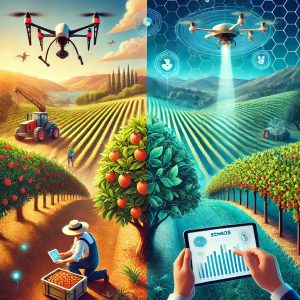Semios: Revolutionizing Precision Agriculture for a Sustainable Future
In today’s world, where sustainability and efficiency are becoming increasingly critical in every industry, agriculture is no exception. The demand for food is rising, but so are the challenges of climate change, resource limitations, and the need to minimize environmental impact. In response to these challenges, Semios, a leader in precision agriculture technology, is empowering farmers with innovative tools to manage crops more efficiently and sustainably.
The Origins of Semios: A Vision for Smarter Farming
Founded in 2010 by Michael Gilbert, Semios was born out of the need to address the inefficiencies in traditional farming methods. Gilbert, with a background in organic chemistry and a deep understanding of agricultural practices, recognized the potential for technology to transform farming. He envisioned a system where real-time data could inform every decision made on the farm, from pest control to irrigation.

AI: DALL-E Generated image Founder representation
The company started with a focus on pest management, particularly in high-value crops like apples, almonds, and grapes. By leveraging pheromone-based monitoring systems, Semios offered a way to reduce the need for chemical pesticides, thus promoting a more sustainable approach to farming.
How Semios Works: Integrating Technology with Agriculture
Semios’ platform is a comprehensive system that integrates IoT devices, data analytics, and machine learning to provide farmers with actionable insights. The platform collects data from various sensors deployed across the fields—monitoring everything from weather conditions to soil moisture levels and pest activity.

AI: DALL-E Generated image illustration data gathering Semios platform
One of the core components of Semios’ technology is its pest management system. Traditional methods often involve blanket applications of pesticides, which can be costly and harmful to the environment. Semios, however, use pheromone traps and sensors to monitor pest populations in real time. This data allows farmers to apply treatments only where and when necessary, reducing both costs and environmental impact.
In addition to pest management, Semios provides tools for climate monitoring and irrigation management. By analyzing weather patterns and soil conditions, the platform can optimize irrigation schedules, ensuring that crops receive the right amount of water at the right time.
Source Yoututbe: Google cloud How Semios uses imported and remote models for inference with BigQuery ML
Success Stories: How Semios is Making a Difference
Over the years, Semios has grown its presence globally, helping farmers improve yields while reducing their environmental footprint. One such success story is that of a large almond grower in California. Faced with the challenge of managing pests like navel orangeworm, which can devastate crops, the grower turned to Semios for a solution.
Using Semios’ pheromone-based monitoring system, the grower was able to significantly reduce pesticide use while still effectively managing the pest population. The data-driven approach not only saved money on chemical treatments but also resulted in a healthier crop with higher yields.
Another example is a vineyard in France that adopted Semios to manage grapevine moths and other pests. By integrating Semios’ sensors and analytics into their operations, the vineyard was able to reduce chemical applications by 30%, all while maintaining high-quality grape production.

AI: DALL-E Generated image with and without Semios illustration
The Impact of Semios on the Future of Farming
The success of Semios goes beyond just improving crop yields; it’s about fostering a more sustainable and resilient agricultural industry. As climate change continues to pose challenges, the ability to make precise, data-driven decisions becomes increasingly important.
Semios is also at the forefront of the broader movement towards regenerative agriculture, which focuses on restoring and enhancing the natural ecosystems in and around farmlands. By reducing reliance on chemical inputs and optimizing resource use, Semios is helping farmers move towards practices that are not only profitable but also environmentally sustainable.
Challenges and Opportunities: Navigating the Future of Precision Agriculture
While Semios has made significant strides, the journey is not without its challenges. One of the key hurdles is the adoption of new technologies among farmers who may be accustomed to traditional methods. Educating and demonstrating the long-term benefits of precision agriculture is crucial for wider adoption.
Moreover, as the technology evolves, so do the data privacy and security concerns. Ensuring that the vast amounts of data collected from farms are secure and used responsibly is a priority for Semios as they continue to expand their services.
Despite these challenges, the opportunities for growth are immense. The global market for precision agriculture is expected to continue growing, driven by the need for more efficient and sustainable farming practices. Semios, with its proven track record and innovative approach, is well-positioned to lead the charge in this new era of farming.
Join me in exploring innovative solutions across the globe, by subscribing to my YouTube channel, and Instagram. Subscribe and Share this blog for more tech insights and stay ahead of the curve.


